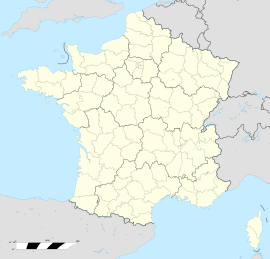Aurouër
| Aurouër | |
|---|---|
| Commune | |

The town hall in Aurouër
|
|
| Coordinates: 46°41′16″N 3°18′01″E / 46.6878°N 3.3003°ECoordinates: 46°41′16″N 3°18′01″E / 46.6878°N 3.3003°E | |
| Country | France |
| Region | Auvergne-Rhône-Alpes |
| Department | Allier |
| Arrondissement | Moulins |
| Canton | Yzeure |
| Intercommunality | Moulins |
| Government | |
| • Mayor (2014–2020) | Alain Borde |
| Area1 | 27.06 km2 (10.45 sq mi) |
| Population (2013)2 | 412 |
| • Density | 15/km2 (39/sq mi) |
| Time zone | CET (UTC+1) |
| • Summer (DST) | CEST (UTC+2) |
| INSEE/Postal code | 03011 /03460 |
| Elevation | 215–262 m (705–860 ft) (avg. 247 m or 810 ft) |
|
1 French Land Register data, which excludes lakes, ponds, glaciers > 1 km² (0.386 sq mi or 247 acres) and river estuaries. 2Population without double counting: residents of multiple communes (e.g., students and military personnel) only counted once. |
|
1 French Land Register data, which excludes lakes, ponds, glaciers > 1 km² (0.386 sq mi or 247 acres) and river estuaries.
Aurouër is a commune in the Allier department in the Auvergne-Rhône-Alpes region of central France.
The inhabitants of the commune are known as Aurouërois or Aurouëroises.
Aurouër is located some 15 kilometres (9.3 mi) north by north-east of Moulins and 20 kilometres (12 mi) south-east of Saint-Pierre-le-Moûtier. The whole eastern border of the commune is the departmental boundary between Allier and Nièvre. Access to the commune is by the D133 road from Villeneuve-sur-Allier in the south-west which passes through the commune and the village and continues east to Saint-Ennemond. The D228 goes north-east from the village to Dornes. Apart from the village there are the hamlets of:
There are large forested areas in the south-east of the commune with most of the rest farmland.
There are many ponds scattered across the commune from which streams flow towards the west to join the Allier.
List of Successive Mayors
(Not all data is known)
In 2013 the commune had 412 inhabitants. The evolution of the number of inhabitants is known from the population censuses conducted in the commune since 1793. From the 21st century, a census of communes with fewer than 10,000 inhabitants is held every five years, unlike larger towns that have a sample survey every year.
Sources : Ldh/EHESS/Cassini until 1962, INSEE database from 1968 (population without double counting and municipal population from 2006)
...
Wikipedia


